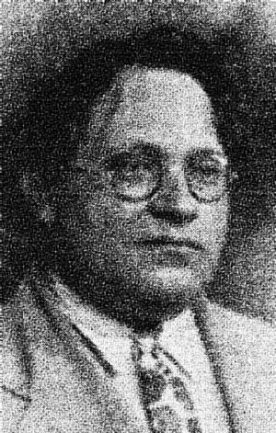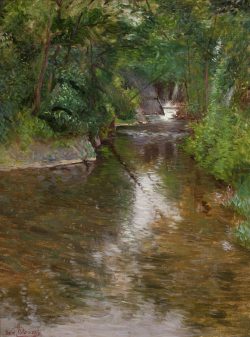Samuel Ostrowsky, from a photograph, source unknown, courtesy of Steven Lasky (www.museumoffamilyhistory.com).

Sam Ostrowsky 1885/6–1946
Samuel Ostrowsky was born in a village near Kiev, Ukraine (then part of the Russian Empire). As a teenager, he studied at the Academy of Fine Arts in Kiev while staying in the home of painter Abraham Manievich. Ostrowsky immigrated to the United States in 1903 to live in Chicago with an uncle. He attended the Art Institute of Chicago on a scholarship, graduating with honors in 1913, and he worked as a commercial artist. In 1912 Ostrowsky married Anna Israelson, daughter of a prominent Chicago rabbi; her career as a schoolteacher allowed him to focus on fine art.
In 1913 the Ostrowskys went to Paris, where the artist studied at the Académie Julian. With the outbreak of World War I the following year, they were forced to return to Chicago. Ostrowsky taught painting at the Milwaukee Art Institute (now the Milwaukee Art Museum) and later at the Jewish People’s Institute on Chicago’s West Side. In addition to portraits and, later in his career, still lifes, he painted landscapes, particularly in Provincetown, Massachusetts, and in the Hudson River Valley. An article on Ostrowsky’s work appeared in Chicago’s Fine Arts Journal in 1916, when his landscape paintings were featured in a solo exhibition at a local gallery. The following year he made his debut in the Art Institute’s “Chicago and Vicinity” annual exhibition; until the early 1940s he frequently was represented both there and in the yearly American art salon. In 1938 the Standard Club of Chicago presented a solo exhibition of Ostrowsky’s paintings.
In addition to easel paintings Owstrowsky created theater sets for productions in Chicago and, beginning in 1921, in New York, notably for Yiddish-language productions. While maintaining a studio in Chicago, he also worked in Woodstock, New York, site of a thriving artists’ colony. This provided him easier access to the city, where he began exhibiting in galleries and museums including the Whitney Museum of American Art and the Brooklyn Museum and with the progressive Society of Independent Artists. A series of extended trips to France between 1925 and 1928 brought the artist into a circle of mostly Russian-Jewish artists, including Marc Chagall and Chaim Soutine. In the late 1930s Ostrowsky participated in the Salon d’Automne and Salon des Tuilleries exhibitions, and in 1939 the French government purchased one of his portraits. At the start of World War II, Ostrowsky and his wife were able to leave France for the U.S. only thanks to the intervention of Premier Leon Blum, a personal friend. No doubt because both his parents died in the Holocaust, Ostrowsky’s work in the war years assumed a darker tone. Four years after his death in Chicago, a selection of the artist’s paintings was appended to the fifty-fourth “Chicago and Vicinity” exhibition as a memorial tribute.
Wendy Greenhouse, PhD
